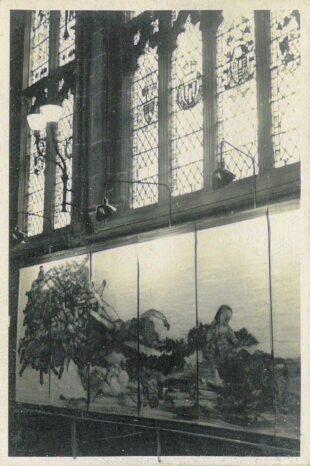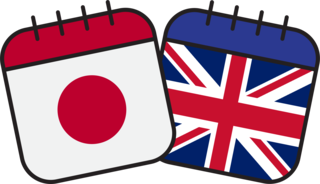
Installation view at St. Mary’s Hall in Coventry in 1955 © Maruki Gallery for the Hiroshima Panels
HIROSHIMA by Iri Maruki and Toshiko Akamatsu
- 20 July - 19 September 2022
- Daiwa Anglo-Japanese Foundation, 13/14 Cornwall Terrace, Outer Circle, London NW1 4QP
- https://dajf.org.uk/exhibitions/hiroshima
- 020 7486 4348
- events@dajf.org.uk
- Tweet
A private view of this exhibition will be held on 19 July 2022. For more details, please visit the Daiwa Foundation website.
The Hiroshima panels have been brought to this country by Artists for Peace, a grouping of artists with greatly differing political and aesthetic views, but united in their realisation that atomic war would destroy all that Britain is and stands for.
The Paintings are a warning and a protest against the untold suffering caused by one small atom bomb.
But they are not horror pictures; nor are they rhetorical. They were painted by a Japanese man and his wife. Their vision has gone beyond revenge or any dogma.
Calmly, quietly, rationally, but with complete and absolute determination we must follow up their protest until no bombs exist. On that depends, not only our claim to any civilisation at all, but the actual future existence of everything that in the most personal, individual, intimate way each of us may love.
John Berger, 1955
Iri Maruki got on the first available train from Tokyo to Hiroshima after 6 August 1945. A week later, Toshiko Akamatsu ( also known as Toshi Maruki) followed him in search of his relatives and friends. They witnessed the aftermath of the atomic bomb, which resulted in the death of over 140,000 people – and the subsequent physical, mental and social effects on the general public. Five years after the period they spent at the scene of the catastrophe, among burnt people, animals, personal effects, infrastructure and buildings, Toshiko and Iri exhibited their first large-scale panel in the Genbaku no Zu series, also known as the Hiroshima Panels which subsequently stretched over 32 years and yielded 15 works. The last piece in the series was entitled Nagasaki. Their works and their devotion are not stories of the past, but are something we need to keep revisiting to question, doubt and criticise power and violence, and to remind us of sorrow.
As the pair developed these panels, more people shared their stories, adding to the moments of despair and the other memories depicted. In order to create these expansive works, the artists drew more than 900 human figures, reflecting how their lives were forced to stop. The panels became an apparatus to tell the stories to general public while topic of atomic bombs in Hiroshima and Nagasaki was censored, then the protests against the coexistence of nuclear weapons and humanity by the artists and their supporters.
In this exhibition, entitled Hiroshima by Iri Maruki and Toshiko Akamatsu, the Daiwa Anglo-Japanese Foundation showcases the drawings and archives in the hope that the world will never have to face the use of nuclear weapons again, and that no other artists feel the need to make panels like this. The exhibition is also dedicated to individuals who face up to fear, away from the public gaze today. Our exhibition of Marukis artworks aims to reflect and rethink the consequences of nuclear war in the present global context, its violence and suffering by the public. We hope to pass the message from the past experiences to the future generation.
The archive highlights the missing link in the information of international exhibitions between 1953-64, in particular the focus of English tours in 1955, also titled Sekai Jyunrei (International Pilgrimage) by the artist. The artworks have been traveling nationally in Japan since 1950 which garnered attention to stage the international show and led artists to be awarded the International Peace Prize by the World Peace Council in 1953. It was thought to be around this time that the panels in English became known as the Hiroshima Panels. Fear and anger towards the Cold War contributed to the peace gesture of inviting Maruki’s works, creating transnational solidarity: in this way, the panels act as peace monuments. The Hiroshima Panels had traveled internationally and works were exhibited in over 20 countries around the world during the Cold War period alone. Although the Cold War has now ended, confrontation between the powers continues, perhaps heading towards a new nuclear age.
About the contributors
Iri Maruki and Toshiko Akamatsu
Iri Maruki (1901–1995) was born in a small village in Hiroshima. He was part of avant-garde artist groups such as the Rekitei Art Association and the Bijutsu Bunka Association. His unique style of suibokuga (ink wash painting), influenced by pre-War surrealist and abstract art, established his reputation. When the duo arrived in Hiroshima just days after the atomic bombing, they assisted surviving members of Iri’s family and were first-hand witnesses to the aftermath of the nuclear attack.
Toshiko Akamatsu (also known as Toshi Maruki) (1912–2000) was born in Hokkaido, where her father was the head priest of Zenshōji Temple. She studied oil painting at the Women’s Academy of Fine Arts (now Joshibi University of Art and Design), and later spent time in both Russia and Micronesia as a private tutor in order to see actual artworks beyond catalogues, which were difficult to access in pre-War Japan. Studying at university, moving away from home to study, focussing on oil painting instead of Japanese painting, and traveling overseas were extremely rare, but even more so for a woman. She was the motivational force in continuing the panels to get across their message when Iri retreated from the work under the pressure of criticism. Toshiko later garnered attention as an author of the children’s books Hiroshima no Pika and Tsutsuji no Musume. She was actively participating in women’s international congresses.
Their collective practice can be described in today’s terms as socially engaged painting, due to their committed fieldwork and continuous engagement with people affected by past events. It was for these monumental works, along with their steadfast efforts to work for peace in Japan and beyond, that the couple were awarded the International Peace Prize by the World Peace Council in 1953, nominated for the Nobel Peace Prize in 1995. A documentary film, Hellfire: A Journey from Hiroshima by John Junkerman which featured Iri and Toshiko on the Hiroshima Panels was also nominated for the Academy Award for Best Dcumentary Feature in 1986.
